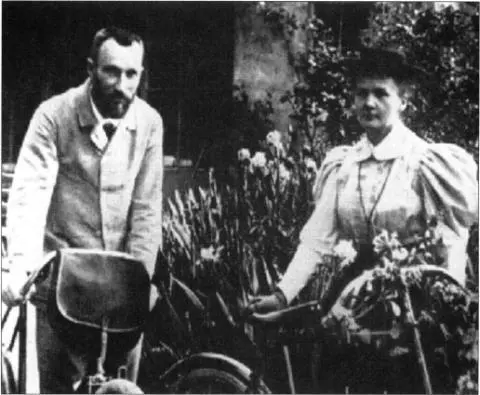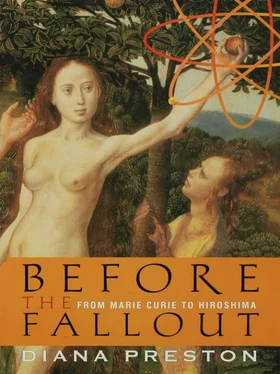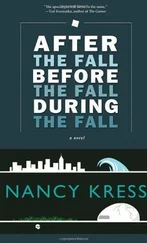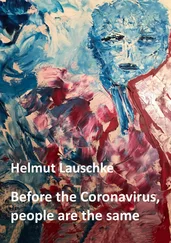Science, particularly mathematics and chemistry, had fascinated Marie from an early age. The Floating University provided her with her first taste of working in a laboratory, albeit an illicit one, concealed from the prying eyes of the authorities in a Warsaw museum. Casting around for a suitable foreign university in which to complete her scientific education, Marie was attracted to the Sorbonne, part of the University of Paris. Not only did it have a high reputation for science, but many of Poland’s intellectual elite had settled in Paris.
However, the Sklodowskis were perennially short of money. Marie’s chances of achieving her ambition seemed remote until she identified a way of helping both her elder sister Bronya and herself. She would work as a governess and send all her wages to fund Bronya’s medical studies in Paris. Then, as soon as she had qualified as a doctor, Bronya would send for her younger sister and, in turn, support her through her own studies. Refusing to listen to Bronya’s objections, the eighteen-year-old Marie secured a post with the Zorawski family fifty miles north of Warsaw and set out in the depths of winter for their manor house. As she later wrote, that cold, lonely journey remained “one of the most vivid memories of my youth.” The final leg was a chilling five-hour sleigh ride across snow-covered beet fields, and she made it with a heavy heart.
Initially, though, Marie found life as a governess bearable, even pleasant. During the day she instructed her employers’ daughters and, applying the philosophy of the Floating University, also taught the local peasant children. In the evenings she pursued her own studies by candlelight. As she later recalled, “During these years of isolated work… I finally turned towards mathematics and physics, and resolutely undertook a serious preparation for future work.” She also learned “the habit of independent work.” However, Marie’s tranquillity was broken when she and the Zorawskis’ eldest son, Kazimierz, fell in love when he came home on vacation from Warsaw University, where he was studying mathematics. Although his parents liked Marie, they refused to contemplate their son’s talk of marriage to a woman they considered socially inferior. Eventually Marie left the Zorawskis, where, as she confessed to her brother, the “icy atmosphere of criticism” had become intolerable. She had still hoped that Kazimierz would show the strength of character to defy his parents and marry her, but finally, four fruitless years after their first meeting, she accepted that he would not.
Bronya, by then a physician and married to another Polish doctor, had been urging Marie to come to Paris. At last, in November 1891, the twenty-three-year-old Marie bought the cheapest possible train tickets for the forty-hour, thousand-mile journey to Paris, where she enrolled in the Sorbonne’s Faculty of Sciences. At first she lived with Bronya, but then found lodgings in an attic room on the Left Bank, sacrificing all comforts to the one essential: solitude to study in peace. As she later wrote, her room was “very cold in winter, for it was insufficiently heated by a small stove which often lacked coal.” Sometimes the temperature fell so low that the water froze in her hand basin, and “to be able to sleep I was obliged to pile all my clothes on the bedcovers.” When that failed to warm her, she pulled towels and everything else she possessed—including a chair—on top of her. She survived on a meager diet of tea and bread and butter supplemented by the occasional egg. One day she fainted on the street. Bronya carried her home, made her eat a large steak, and lectured her on taking better care of herself, but Marie persisted in her spartan, single-minded existence.
Physical deprivation was unimportant to her. She had found a stimulating intellectual challenge: “It was like a new world opened to me, the world of science, which I was at last permitted to know in all liberty.” She passed her licence es sciences physiques [3] The licence es sciences is comparable to a bachelor of science degree.
in 1893, not only top of the class but also the first woman to receive such a degree. She took her licence es sciences mathematiques in 1894, coming in second in her class. While she was still preparing for her mathematics exams, the Society for the Encouragement of National Industry invited her to perform a study of the magnetic properties of steels. She was eager to do so but lacked sufficient room for the necessary equipment in her laboratory at the Sorbonne. Polish friends in Paris came to her aid. They invited her to tea to meet the French physicist Pierre Curie, laboratory chief of the Paris School of Physics and Chemistry. He too was working on magnetism, and they hoped that he might be able to help her.
Pierre’s background, like Marie’s, was radical and progressive. His father, a determinedly republican doctor, Eugene Curie, had tended wounded activists during the rising in 1871 of the Paris Commune—the revolutionary council formed by the workers of Paris after France’s defeat by Prussia. The Communards had gone to the barricades in defiance of the French government, which had concluded an armistice they considered shameful. The Commune lasted ten weeks before being bloodily suppressed by French government forces, leaving some twenty thousand dead. Eugene Curie sent Pierre, only twelve at the time, and his slightly older brother, Jacques, out into the streets to search for wounded people in need of medical care and protection from the troops.
Later, as life returned to normal, Dr. Curie had encouraged his sons to explore the natural world. Both became scientific assistants at the Sorbonne, where, working together in the laboratory of mineralogy, they began studying the structure of crystals. This led them to a remarkable discovery—the phenomenon of piezoelectricity [4] Piezoelectricity comes from the Greek piezein, meaning to “press tight.”
whereby crystals subjected to pressure produce a current—which became the basis for the gramophone. The two young men had developed a piezoelectric quartz instrument capable of measuring the tiny voltages emitted by the crystals.

Pierre and Marie Curie circa 1895
When he met Marie, Pierre Curie was thirty-five years old, introspective and unworldly. Many years before, he had loved a girl whom he described in a private note as “the tender companion of all my hours,” but she had died. Since then he had devoted himself to his work while striving to avoid emotional though not physical entanglements. He believed that “a kiss given to one’s mistress is less dangerous than a kiss given to one’s mother, because the former can answer a purely physical need.” Perhaps as a defense against intellectual engagement, he claimed to believe that “women of genius are rare” and that “when, pushed by some mystic love, we wish to enter into a life opposed to nature, when we give all our thoughts to some work which removes us from those immediately about us, it is with women that we have to struggle.”
After her experience with Kazimierz Zorawski, Marie was wary of relationships. Young students at the Sorbonne frequently declared their passion for the gamine ash blond, excited by her combination of cool intellect and sexual charisma, but none impressed her. Pierre Curie, however, did. As she later wrote, “His simplicity, and his smile, at once grave and youthful, inspired confidence.” Tall, with cropped auburn hair and a pointed beard, he had an unconscious, loose-limbed grace. He was unable to offer Marie accommodation for her experiments, but their meeting sparked an intense relationship. They quickly discovered what Marie called “a surprising kinship” in their ideas. Both believed science to be the world’s salvation. Both believed that they should devote their lives to make it so.
Читать дальше













